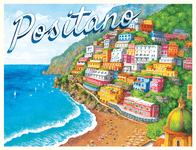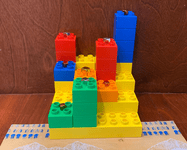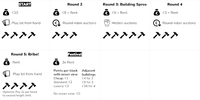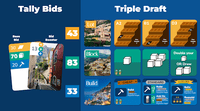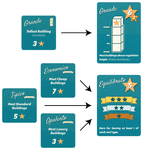
Positano is a light strategy game about building resorts on the scenic Amalfi coast, so it seems appropriate to take the scenic route in how I created the game and teamed up with SlugFest Games to make it.
Inspiration
I keep a running log of game ideas that pop into my head when I’m driving or in the shower or waking up. Most are only a couple of words, like “magmapunk” or “city pigeons”, but for several months, I had this idea sitting in there: “Buildings with ocean views”.
I didn’t start working on turning this idea into a game until I stumbled on this photo of Positano, Italy:
The pastel buildings are captivating as they rise up the hillside to overlook the Mediterranean Sea, and I could instantly imagine a finished game product that captured that vista.
Just as importantly, though, setting the game in Positano could solve one of the issues that was gnawing at me with the initial “buildings with ocean views” inspiration. On a flat gameboard, having beachside property would be way overpowered, but by building in rows on a steep hill, players would be able to snag views of the sea even if they were constructing a building in the back.
Design Goals
I like to define design goals that I can revisit when I’m feeling stuck or struggling to determine a direction when creating a game. These were the original design goals for Positano:
• Dramatic question: “Which player’s buildings will have the best views of the sea?”
• Striking table presence and enjoyable tactile building experience
• Crunchy enough for gamers, but easy enough for families and not-yet-gamers
• Duration: 30-60 minutes
Initial Prototype
I raided my kids’ old toy box for LEGO DUPLO bricks to assemble my first prototype for Positano, then I grabbed copper, silver, and gold cubes from Terraforming Mars to serve as the rooftops denoting different building qualities from cheap to luxury.
The mechanisms of the buildings, roofs, and sea views barely changed from this initial prototype. From the beginning, the core concept of constructing buildings of three different qualities that scored points only for rooms with sea views was intuitive, compelling, and a novel experience for most playtesters. Players thoroughly enjoyed constructing tall, luxury buildings for their own gain, as well as blocking the views of opponents’ buildings to rob them of victory.
On the other hand, the mechanisms of how you acquire the building blocks and select building locations wasn’t so easy! Each iteration of the game changed these mechanisms dramatically. Early on, I had players collecting rent from their buildings and using that money over several rounds with different types of auctions to bid on building qualities and locations. This proved to be a very bad idea!
Playtesting & Challenges
I playtested Positano with four different groups, both in-person and online (using Tabletop Playground):
• Friends and family
• Protospiel Online
• Break My Game
• Chicagoland Boardgame Designers and Playtesters Meetup
It was readily apparent in early playtests that Positano‘s initial system of money-based auctions wasn’t working. Playtesters helped me uncover multiple problems:
• Runaway leader: If a player managed to build one or two great buildings in the initial rounds, they could collect more rent than their opponents and use those earnings to extend their lead.
• Going broke: If a player made early blunders, the game was rather punishing as the player ran short on funds and fell further and further behind.
• Ill-fitting mechanisms: The early Positano auction mechanisms had strong echoes of Reiner Knizia‘s Modern Art — and while that’s a fantastic game and the auctions work great in it, they were poorly suited to Positano.
• Uninspiring role: Some playtesters chafed at the theme of being a landlord and collecting rent from tenants. It had not occurred to me that this could be a turnoff to some gamers. That’s why it’s crucial to playtest with diverse groups of people!
After trying several experiments with the money-based auction system and not seeing the improvements I was looking for, I decided to do something drastic: Eliminate money entirely!
New Mechanism: Two-Card Bid/Triple-Draft
To eliminate a core component from a game, you need to dissect all the functions that the component serves. In Positano, money was used to:
• Bid on locations to build.
• Purchase blocks of varying quality (from cheap to luxury) fro use in construction.
• Score points at the end of the game.
After playing with a few different ideas, I landed on a new mechanism: the two-card bid / triple-draft.
Players have identical hands of two sets of cards: base bids and bid boosters. The base bid cards each feature three numbers that represent the bid strength for drafting order of three different types of cards:
• Lots: the location on the hillside that you’ll build
• Blocks: the number of building blocks that you’ll obtain
• Build: the quality of construction and any special building powers
Players need to choose their priorities each round: Do you want to use your card that has a high number for lots this round, or save it until later? And if you do use it this round, are you comfortable getting only a small number of blocks or a lower quality building?
The bid booster cards augment all three base bids, and players can use these cards to represent how important overall this round of drafting is to them. I found many benefits of the two-card bid / triple-draft:
• Simultaneous decision-making: All players plan their bids simultaneously, which nearly eliminates downtime and cuts down on the duration of the game substantially.
• Conjoined decisions: You’re making a single bid, but the results of it will yield three different types of cards with different drafting orders for each.
• Yomi (reading opponents’ minds): The best Positano players can read their opponents, guess what they might be playing, and know when they’ll want to go big vs. saving some of their high cards for later.
• The big reveal: I love it when games feature a dramatic moment when multiple players reveal hidden information simultaneously to cheers or groans around the table.
Cardboard Edison contest
I entered Positano in the annual Cardboard Edison game design contest, and I was thrilled when Positano reached the finals, making it one of the top 15 games out of over 250 submitted. Here’s the video that I submitted for the contest:
I stuck with the DUPLO blocks and Terraforming Mars cube roofs for the contest because they felt “good enough” for a prototype. They didn’t get in the way of the gameplay, and they painted a sufficient picture for players to imagine what a production quality game could look like.
The Cardboard Edison judges loved the table presence of the game and the ocean view building and bidding mechanisms. Crucially, they also provided helpful feedback to focus on improving the way that tied bids were handled. Originally, players with tied bids would need to submit a second pair of cards to break the tie, which interrupted the flow of the game and led to some unhandled rare exceptions. I implemented and tested a new tie-breaking approach that provides star ratings on the base bid cards. These star ratings are evenly balanced across players, so that drafting order is fair whenever a tie occurs.
I set to work on improving those mechanisms before contacting publishers.
Working with SlugFest Games
I submitted Positano to SlugFest Games because I thought that players of The Red Dragon Inn series would also thoroughly enjoy Positano. Both games sit on the spectrum between light and medium-weight and can be played in 30-45 minutes with have high player interaction.
They loved it! SlugFest and I had a good idea of what the finished product might look like, and the team has brought their know-how regarding manufacturing and production design for the game’s various unique components. They also had a long history of successful Kickstarter campaigns to (hopefully) ensure Positano‘s would be a success. They got cracking on sculpting unique building blocks for each player, commissioned fantastic artwork, and generally gave the game the table presence it deserved. Additionally, the SlugFest crew has refined and enhanced the game in some key ways:
• Adding a 5-6 player expansion with a bigger cliffside.
• Adding a clever solo mode that asks you to partner with an automa-player rather than competing.
• Adding new goals and refining goals and scoring to make decisions even more interesting and increase replayability.
SlugFest streamlined set up by eliminating the four different categories of goals that I had been using, instead providing cards that have goals on both sides, which prevents conflicting goals from being in the same game. The new goals provide juicier decisions for maximizing points each round. I think my favorite new goal is “Altezza”, which awards points for having buildings of different heights.
We playtested these updates together, and there was a strong sense of collaboration as we worked to make the finished product as good as it could be.
It was thrilling to see the in-progress updates from the SlugFest team as they evolved my DUPLO prototype into a real-looking game, and I can’t wait for all of you to try it out!
• Positano is available for purchase in retail stores starting in Q2 2025.
• Jonathan Cox’s “Learn While Playing” video provides an in-depth look at the gameplay.
• If you’d like to give Positano a try, you can play it on Tabletop Simulator.
BoardGameGeek News | BoardGameGeek
